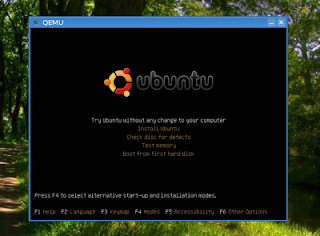

#Qemu boot iso install#
The -curses option gives a correct result with an install iso, when the 640 x 480 Graphic mode message appears, I use to access the boot: menu of grub and I pass it the install vga=normal fb=false options and it goes ( screenshot)īut with the Live iso, it doesn't work ( screenshot) drive file=/tmp/11-live-amd64-std.iso,media=cdrom -boot c

Qemu-system-x86_64 -curses -net nic -net user -m 1024M
#Qemu boot iso windows#
Ive been able to boot from the Windows XP CD, the Debian iso image, etc.
#Qemu boot iso mac#
The problem is that Hyperkit.Framework fails to pass this feature through, leading to the crash. 11 When I try to boot a virtual machine using: qemu-system-x8664 -m 1024 -cdrom /host/iso/ -name mac -hda /ubuntu Iget a black screen just after the installation begins (before I choose the Language). Ubuntu 20.04 was crashing because it attempted to use the RDTSCP feature which is supported by the CPU. To explicitly use the emulated CPU, your command-line would look as follows: qemu-system-x86_64 \Ī response to my bug report solved this for me. Using QEMU 5.1 from HomeBrew, I have had success emulating the CPU by using the default qemu64 CPU model. When I try to boot the Ubuntu 20.04.1 desktop installer ISO, I get a kernel panic immediately after the boot loader's splash screen. I have had similar issues when using the hvf accelerator with CPU host passthrough. These are the command parameters I am launching my VM with. I'm unsure if this is specifically an hvf issue, but any suggestions are welcome. 1 Situation: A server: access only via SSH (no physical access, no KVM) a netboot OS (Debian/Jessie) 3 x 2T HDD 16G RAM Final goal: Building a ZFS pool with the local HDD and install Debian on a ZFS root, the netboot OS is missing packages to install ZFS via apt, that's why I want to boot a Live Debian. Instead, and made no apparent difference in the case of the Kali and CentOS isos. I attempted to also boot with the notsc kernel flag enabled, this however merely caused the Mint ISO to hang at PCI Interrupt Link enabled at IRQ 10 The CentOS VM exits abruptly when booted in verbose mode after a flash of text too fast for me to read, whereas the Kali iso merely shows a black screen, without even a blinking cursor. I have also attempted to boot a CentOS and Kali iso. qemu-system-x8664: -device ide-cd,buside.1,unit0,drivelibvirt-1-format. I am able to get as far as the boot menu, but attempting to boot into the installer leaves me with a blinking cursor.īooting in verbose mode, I see it hangs at: Tried the following: gnomeosinstaller.iso. Attempting to boot from a Live Linux Mint 18.4 (圆4) ISO using QEMU under macOS Catalina (with patches to use hvf as hypervisor in place of kvm).


 0 kommentar(er)
0 kommentar(er)
